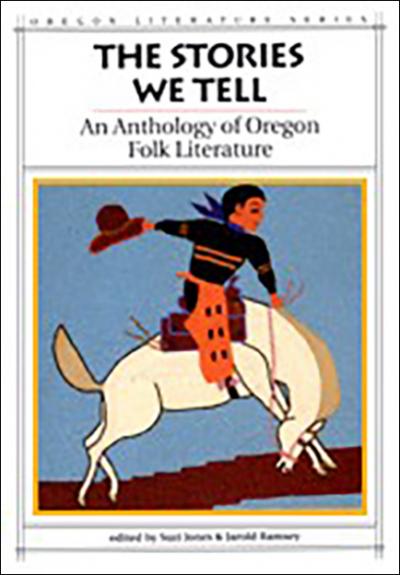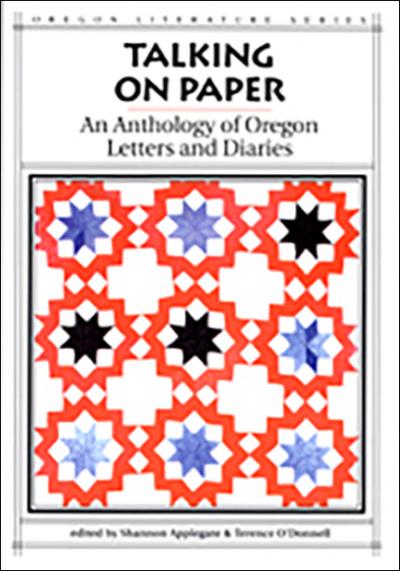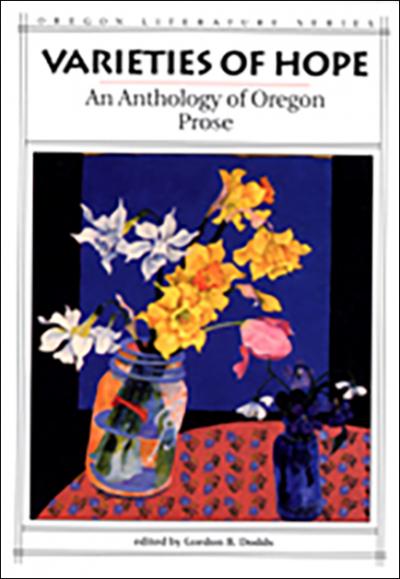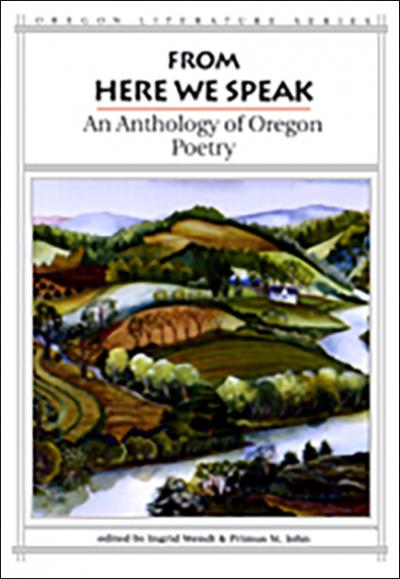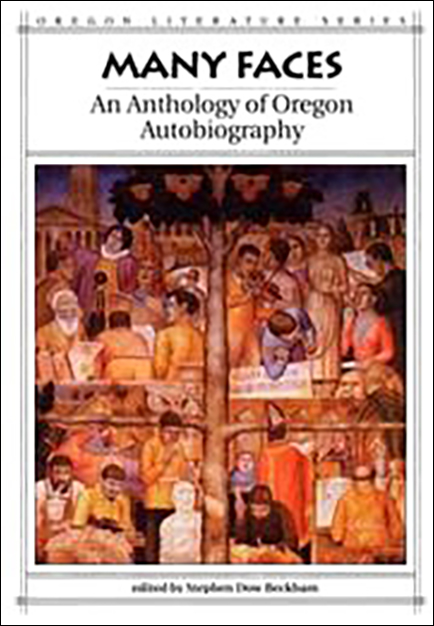
ISBN 9780870713712 (hardcover)
Many Faces
Stephen Dow Beckham
Illustrated with art by Oregon artists.
The Oregon Literature Series is a unique cooperative effort of the Oregon Council of Teachers of English, which commissioned and created the series, and the Oregon State University Press. The series is designed to appeal to general readers as well as to students and scholars, and is already attracting national attention as a model for literature in the schools.
This volume tells, in their own words, the stories of Oregonians from the prominent to the plain. Here we are given glimpses into lives as different as those of Lydia Taylor, a prostitute; William O. Douglas, Supreme Court Justice; and J.A. Wisdom, whose father (and owner) sold him into slavery for $400. Here are Barry Lopez, writing about his attempts to wrestle meaning from the river near his home; John Reed, about to turn thirty; Bethenia Owens-Adair, one of Oregon's first women doctors; and Annie Miner Peterson, who dictated many hours of Native American oral literature to anthropologists in the 1930's.
"Terrible times when I'm baby. Rogue River Injun war that time,' recalled an aged resident of the Siletz Reservation in 1912. This man's voice from the past and others--recorded on wax cylinders by linguists and anthropologists--tell the other side of the deeds of the Oregon pioneers...Oregon gold miners, ranchers, school teachers, salmon cannery workers, loggers, and others also penned their life stories. These first-person accounts are real, if sometimes self-serving; they are the fabric of history and the human experience. Oregon autobiographies speak to the diversity of life and labor and human response to a land with many faces."
Stephen Dow Beckham
About the author
Stephen Dow Beckham holds the Pamplin Chair of History at Lewis & Clark College. A graduate of the University of Oregon and the University of California, Los Angeles, he has taught courses on Native Americans and the American West for 35 years. Beckham was named "Oregon Professor of the Year" and is recipient of the Asher Distinguished Teaching Award, American Historical Association.
Beckham has researched and written Federal Acknowledgment petitions, testified in federal district court and the U.S. Claims Court, and testified before Congress in matters related to Indian tribes. He has assisted tribes in enrollment documentation, clarification of reservation status and treaty rights, and mounted a number of teacher institutes through the Indian Education Act and its amendments.
Beckham's other books include Requiem for a People: The Rogue Indians and the Frontiersmen, Tall Tales from Rogue River: The Yarns of Hathaway Jones, Many Faces: An Anthology of Oregon Autobiography, and The Literature of the Lewis and Clark Expedition. He is a contributing author to several volumes of the Handbook of North American Indians and to Native Americans in the Twentieth Century.
Read more about this author
Contents
General Introduction
Introduction: Listening to the Many Voices
Northwestern Oregon
Alexander Ross, "Astoria: The First American Settlement"
Jesse A. Applegate, "Our First Winter and Summer in Oregon"
Abigail Scott Duniway, "I Was Nothing But a Women"
Homer Davenport, "A Country Boy"
Laurence Dowrick Pratt, "Memories of Portland, 1899-1915"
Amanda Gardener Johnson, "Seven Generations I Have Known"
James Beard, "The Good Life of a Gourmet"
John Silas Reed, "Almost Thirty"
Mary Barnard, "Student Days at Reed College"
Clyde Rice, "Sailing the Bunky to California"
Luther Sheeleigh Cressman, "Becoming an Archaeologist"
Beverly Bunn Cleary, "The Great Depression"
Kim R. Stafford, "The Separate Hearth"
Madeline DeFrees, "Writing from the Margins"
Primus St. John, "The Way the World Has Entered"
Southwestern Oregon
J.M. Kirkpatrick, "The Heroes of Battle Rock"
Herman Francis Reinhart, "A Pacific Rancher, 1853-1855"
John Adams, "Awful Hard Time When I'm Baby"
Bethenia Owens-Adair, "The Story of My Life"
Robert Deniston Hume, "The Salmon King"
Annie Miner Peterson, "A Coos Indian Woman Looks at Life"
Jesse Louetta Hatfield Wright, "Married at Sixteen"
Claude Riddle, "Early Day Deer Hunting"
Angus L. Bowmer, "Shakespeare Comes to Ashland"
Curt Beckham, "Gyppo Logging Days"
Lawson Fusao Inada, "Living in the Northwest"
Central Oregon
William Thompson, "Reign of the Vigilantes"
Reuban A. Long, "A Boy on a Horse on the Desert"
Joseph Nathan Teal, "Adventures of a Buckaroo"
Erskine Wood, "Bears and Trout"
Dorothy Lawson McCall, "Christmas on the Crooked River, 1911"
Harold Lenoir Davis, "Childe Herald"
Jarold Ramsey, "Memories of Agency Plains"
Mitzi Asai Loftus, "Executive Order No. 9066"
Dayton Odgen Hyde, "Don Coyote"
William Kittredge, "Owning It All"
Eastern Oregon
Sarah Winnemucca Hopkins, "Life at the Malheur Agency"
Bill Hanley, "I Start Out for Myself"
Evelyn Gilcrest, "Alvord Ranch Interlude"
Grace Edgington Jordan, "A Lost Child in Hells Canyon"
William Ashworth, "Coming of Age in the Wilderness"
Molly Gloss, "Reading and Writing Westerns"
Lois A. Wenzel, "I Am Native American"
Bibliography
Copyright Acknowledgements
Index
The idea for the Oregon Literature Series, six anthologies of the best Oregon writing, was first proposed to the Oregon Council of Teachers of English (OCTE) in 1988. At that time, OCTE decided to depart from the conventional state literary anthology--a monolithic tome put together by a few academic volunteers and generally intended for libraries and adult readers. Instead, OCTE decided to create six shorter, genre-based anthologies: prose, poetry, autobiography, folk literature, letters and diaries, and short fiction. OCTE would publish a public "Call for Editors," and the most qualified individuals would be hired for their expertise and treated professionally-honoraria, expenses, research assistance, travel, etc. The anthologies would be intended as classroom/reference texts for students and teachers, and as introductory readers for the general public. Books would be designed to be easily held, carried, and read.
Numerous arguments were raised against this innovative proposal--most of them signaling Oregon's 150-year status as a literary colony. No one had ever done this before. Oregon's literature was non-existent. There wasn't much writing of merit. Most scholars and critics have ignored Oregon literature--even in the best histories of Western literature. There's no literary history of Oregon. It will take years to find this work. In Oregon, literature has the least financial support of all the major arts. We had no publisher. It might rain.
Nevertheless, in 1989, Ulrich Hardt and I were appointed by OCTE to complete the Oregon Literature Series. The work began when we signed a publication contract with Oregon State University Press, our first and most important professional collaborator. Next, from a pool of 139 applicants, OCTE chose these editors to discover Oregon's literary heritage: Shannon Applegate, Stephen Dow Beckham, Gordon B. Dodds, Primus St. John, Suzi Jones, Glen A. Love, Terence O'Donnell, Jarold Ramsey, and Ingrid Wendt. Appointed in August 1990, those individuals began the search for Oregon writing that eventually spread beyond every corner of the state--from ranch houses to university archives, from oral storytellers in Longhouses to Chinese Miners' letters in museums, from Desdemona Sands to Burns. Some editors traveled thousands of miles. Others corresponded with hundreds of authors. Most read thousands of pages. Poets, historians, folklorists, critics, scholars, teachers, and editors--they all benefited from and shared their research expertise. Even though honoraria were small, editors gave generously of their time. While the editors looked for Oregon writing, Ulrich Hardt and I sought out and received endorsements from many major cultural and arts organizations. Financial support was like rain in the time of drought, but we attracted a few wise, faithful, and generous patrons, as the Acknowledgements record.
Once the editors had discovered this vast, unstudied, and unknown body of writings, they assembled their manuscripts by using the following guidelines--guidelines that required them to choose writing--in its broadest sense--that might reveal the Oregon experience to both students and the public:
- The volume must include a representative sample of the best Oregon writing from all periods, regions, occupations, genders, genres and sub-genres, ethnic, religious, political, and cultural backgrounds.
- Oregon birth should not be used as a single criterion for inclusion. Oregon residence is important, but no arbitrary length of stay is required for a writer to be included.
- Works about experience in Oregon are preferred, but editors are not limited to that criterion alone.
- "Oregon" will be defined by its changing historical boundaries--Native American tribal territories, Spanish, Russian, British, U.S. Territory, statehood.
- One or more translations and original from non-English languages should be included when appropriate to show that linguistic multiplicity has always been a part of Oregon.
- Controversial subjects such as sexism and racism should not be avoided. Multiple versions of events, people, and places should be included when available.
- Length of works must vary; limit the number of snippets when possible. Meet the need of diversity in reading, from complex to simple.
- New, unknown, or unpublished work should be included.
- Works will be edited for clarity but not necessarily for correctness. Editors may invent titles, delete text, and select text as appropriate and with appropriate notation.
Once assembled in draft, most of these manuscripts were two to three times longer than could be published by Oregon State University Press; Therefore much fine writing had to be omitted, which all editors and our publisher regret. After being reduced to the requisite size, the manuscripts passed through two separate reviews: first, a different Advisor Board for each volume read and rated all selections; second, the Editorial Board composed of all fellow editors of the Oregon Literature Series read, responded, and eventually voted to adopt the manuscript for publication. At all stages, both Ulrich Hardt and I worked closely with editors in may ways: readers, critics, fundraisers, administrators, arbitrators, secretaries, grant writers, researchers, coordinators, pollsters.
Now, we hope that these books will create for Oregon literature a legitimate place in Oregon schools and communities, where the best texts that celebrate, invent, evaluate, and illuminate the Oregon condition have been invisible for too long. Here, for the first time, students will have books that actually include writing by Oregonians; and peoples in the state; librarians will be able to recommend the best reading to their patrons; the new reader and the general reader can find answers to the question that has haunted this project like a colonial ghost "Who are Oregon's writers, anyway?"
Let it be known that an Oregon literary canon is forming--rich, diverse, compelling. Here we give this sample of it to you. Let your love of reading and writing endure.
Grand Rhonde Valley, Oregon, September 1992
Introduction: Listening to the Many Voices
Autobiography is a literary genre which both reveals and conceals. The self-written account of one's life, unlike biography, has passed through a lens of editorial control suggesting obvious potentials for avoiding unpleasant truths, obscuring missteps, hiding errors, and covering up. While readers may engage autobiography for its authenticity and detail, it is best approached cautiously for a variety of reasons. Readers of autobiography need to pose several questions. Did the author write only for close family and friends or for a wider audience? Did the author seek to use the autobiography for political, social, economic, or other purpose? Did the author use the autobiography to vent animosity or cope with anxiety? These questions arise over and over in assessing autobiographical works. None has an easy answer and not all autobiographies fully reveal why the author wrote or dictated them for another to record. Oregon autobiographies include examples of many purposes and multiple intended audiences.
"A wonderful fact to reflect upon," wrote Charles Dickens in A Tale of Two Cities, every human creature is constituted to be that profound secret and mystery to every other." Such is the nature of autobiography that many who have embarked upon the mission have kept secrets and sustained mystery. They have told a bit about their lives and labors but have filtered what they have said. Autobiography, by its very creation, is a personal editorial, a statement of what a person considers is central to having been. The autobiographer speaks to specific subjects and hints at topics not explored. The writer occasionally permits the reader to peer through windows of experience but vaguely opened. Sometimes the windows appear as but dim portals; the shutters are nearly fully closed. Autobiographies compel the reader to look beyond a writer's public persona and seek the hidden person. The reader has to pursue both the image and the shadow, for collectively only such close attention to text can lead to grasping the fuller story.
Why some have felt impelled to record their life's experiences is not a mystery. Human nature leads individuals to seek affirmation. In a very real sense, autobiography is a process of self-affirmation and, for some, a grappling with existence. "One must pay dearly for immortality," wrote Friedrich Nietzsche, for "one has to die several times while still alive." Autobiography is thus, perhaps, the final and highly personal battle waged on mortality. It is a purposeful recording of what an individual considers to have played a central role in his or her life. It may be self-serving, angry, humble, or even inarticulate. It is above all, however, the work of self-assessment and, at its best, a reflective self-revelation. At its worst, it is filled with half-truth and even slander.
Autobiography contains several types of writing. The adventure or exploration tale surfaces frequently in Oregon's early history. A number who faced the frontier wrote of their trials and triumphs over nature or the American Indians who held this land. The narrative of Alexander Ross of the Pacific Fur Company and the collection of Oregon pioneer autobiographies in the Bancroft Library fall in this category. A second type, the rags-to-riches tale, recounts an individual's rise to wealth and influence. Burt Brown Barker who retired from law practice at age fifty and passed most of the next forty-five years of his long life in public service in Oregon, wrote in this manner. The confessional or conversation tale, crafted by a person whose life was transformed, is a third type. The sad narrative of Lydia Taylor, a turn-of-the-century Oregon prostitute who wrote From Under the Lid: An Appeal to True Womanhood (1914), proved more a confessional than a conversion piece. Oregon autobiography also speaks persuasively to the triumph of emigration tale. Bill Hanley, Robert D. Hume, and David Shirk spoke with pride about how their moves from someplace else confirmed the value of their relocation decisions. Similarly Jessie Wright's homesteading years on the North Umpqua fit in this theme. Bill Kittredge, Kim Stafford, and Barry Lopez have crafted a fifth type of first person tale: an advocacy for the land and life essay which draws on ordinary adventures. They have brought the ordinary into transcendent value through the insight of common sense and, in some instances, ecological justice.
Oregon autobiography has emerged from several different sources. Sometimes it was a solicited literature, drawn by an organization or a researcher. Other times it had a journalistic origin and resulted because of the chance to recount in serial format a life story in a weekly newspaper. In its most common and successful format, autobiography came from the head and heart of people who wanted to tell their own story. These intensely personal accounts have, perhaps, best stood the passing of time.
Sometimes autobiographies have resulted from coaxing or solicitation of others. In the nineteenth century the Oregon Pioneer Association assembled annually to celebrate its members' roles in settling the Pacific Northwest. The organization invited an illustrious pioneer each year to deliver the "annual address," invariably a firsthand account of crossing the continent or helping establish a new community on the Pacific Slope. The OPA's Transactions printed these lectures and included, as well, autobiographical reminiscences to fill out the volumes. These first person statements have not fared well with passing decades. Unlike the diaries kept by overland travelers, the personal reminiscences were often cloaked in patriotism and self-congratulation. They are dated and but modestly valued.
In the 1870s Hubert Howe Bancroft, the California historian and publisher, launched the countdown to his ambitious thirty-nine volume History of the Pacific States. Although he had amassed the largest library of Western Americana ever assembled, Bancroft realized that much of the information he needed remained in the memories of those who had helped transact the events of history. Thus Bancroft initiated what, in essence, became the first oral history project West of the Rockies to yield written narratives. Bancroft solicited dozens of autobiographies from aging pioneers. If these people proved important in his projected accounts and seemed unable to write, he or his staff sought out the informants and took down verbatim their autobiographical dictations. Martha Ann Minto's "Female Pioneering in Oregon," Joseph Lane's "Autobiography" Ninevah Ford's "The Pioneer Road Makers." and Lafayette Grover's "Notable Things In a Public Life in Oregon" were among the several dozen accounts solicited and added to the Bancroft Library. These works remain mostly unpublished, for they are episodic and unpolished. They represent an interlude in first person Oregon history that contributed to the Bancroft volumes about the Pacific Northwest but little more.
Many Oregon autobiographies emerged because of the sense of aging persons that they ought to share a bit of what their life had been with their children, or more particularly, with their grandchildren. In this regard, emphasis on rudimentary living, hardship, isolation, poverty, making-do, and diligent work became common themes in accounts by ordinary people coping with life in the Pacific Northwest. While the nineteenth century generations sometimes had a dramatic moment of overland travel or confrontation with Indians to color their narratives, more recent authors of autobiographies have concentrated on eking out an existence by determination and sheer necessity. The adversity of those who homesteaded marginal lands in the years 1860 to 1940 or, more recently, those who have written about life during the Great Depression have perpetuated theses themes.
Fred Lockley, the "Oregon Journal Man," solicited several hundred autobiographical vignettes from residents of the state in the 1920s and the 1930s. Lockley used these accounts in his newspaper columns and in his books Oregon Folks, Oregon's Yesterdays, and Oregon Trail Blazers. The triumph of emigration theme played through hundreds of Lockley's pieces perhaps because he sought out those who were aged and who had emigrated to Oregon from someplace else. Amanda Gardener Johnson, the African American octogenarian of Albany, for example, told Lockley of the good life she found in the Willamette Valley.
Newspapers in many Oregon towns gave voice to autobiographical efforts, sometimes in weekly installments. Robert D. Hume's "A Pygmy Monopolist" appeared in 1904-1906 in the Wedderburn Radium, while George Riddle's Early Days in Oregon: A History of the Riddle Valley appeared in 1920 in the Riddle Enterprise. Hume's story of migration and settlement contained elements of the rags-to-riches tale, a theme echoed in Angus Bowmer's chronicle of transforming sleepy Ashland into the city of Shakespearean festivals and cultural fare. Riddle clearly wrote a settler's tale. So too did a more recent Oregonian--Lawson Fusao Inada who, like Bowmer, found in Ashland a meaningful life and a good place for "Living in the Northwest." Autobiography of various themes has thus flowed in essays, weekly columns, and from job presses at newspaper offices and enabled authors to get their words set in type and bound for a relatively modest fee. Many Oregon autobiographies are self-published, limited edition works. By their publication history it is clear they were intended for family, friends, and local consumption. Others, however, secured regional and even national markets.
In the 1930s the Works Projects Administration mounted another type of autobiography program: hundreds of short interviews with the state's aged residents. As in the Bancroft and Lockley projects, the triumph of emigration theme dominated. In these accounts few confessed, hardly any explored, most took pride in their triumphs over nature, and almost all fell short of riches. While many of these typescripts--most of them in three-ring binders held by the Forest Service or county historical museums--show promise for compelling autobiography, none gained completion. Local historical societies have published a few of these accounts.
Voices of Oregon minorities are rare in autobiographical format. Bancroft did not seek them out and wrote his detailed histories of settlement and conflict with Indians almost completely ignoring the Indian view of history. Even thought Frances Fuller Victor crafted most of the Northwest volumes in Bancroft's set, women, too, played little role in her accounts. Lockley did better. As a journalist, he sought out and interviewed women, African Americans, and ordinary folks as well as those with notable names. Sarah Winnemucca Hopkins and Chief Joseph, through their association with writers and Indian rights advocates in the East, gained publication in the nineteenth century. Their situation was exceptional.
Although linguists and anthropologists worked with Oregon Indians to record thousands of pages of notes on material culture, kinship systems, literary texts, and vocabularies, few bothered to ask even the most rudimentary questions about the life histories of their informants. The manuscripts of Albert Gatschet on the Klamath, Edward Sapir on the Wishram, J.O. Dorsey on the Siletz tribes, and Leo J. Frachtenberg on Oregon's coastal Penutian-speakers contain little about the individuals who provided so much of the data they penned. John Peabody Harrington's several thousand pages of field notes, for example, were so cryptic that it has taken years to unravel the identity of those Indians with whom he labored for weeks or months to record data for the Smithsonian Institution. Exceptions were Edward S. Curtis, photographer and writer, and Melville Jacobs, anthropologist and linguist of the University of Washington. Both identified their informants and took down life histories. IAwful Hard Time When I'm Baby by John Adams of the Siletz Reservation and A Coos Indian Woman Looks at Life represent accounts preserved during the course of their anthropological work.
A number of Oregon autobiographies have emerged from the first person essay. Reub Long's A Boy on the Horse on the Desert, Evelyn Gilcrest's Alvord Ranch Interlude, William Ashworth's Coming of Age in the Wilderness, and Kim Stafford's A Separate Hearth, are marvelous pieces both descriptive of place as well as revealing of character and personality. Such works often serve double purpose. They may be essays of place or history yet, in the course of telling, emerge as compelling autobiography. At first glance they are narrative. At closer scrutiny they display the shadows and special meanings the reader should seek and glean from the words.
Some autobiographers wrote with more explicit purposes. Such works contain both self-portraiture as well as seeking to convert the reader to a revised point of view. Bethenia Owens-Adair, doctor and suffrage leader, told her life's history to express appreciation to men who had helped her and to condemn those who had wronged her. Her life's history is a rags-to-riches and "you better listen to me" tale. Sarah Winnemucca Hopkins' autobiography was as much a plea for change in federal Indian policy as it was the story of her life. Abigail Scott Duniway's Pathbreaking was both life story, suffrage history, and argument for equal rights for women.
Not uncommon is Oregon autobiography is the unvarnished account of a life well lived. However, such narratives often deal with the American paradox: how can a person grow up poor, isolated, or remote from the main currents of cultural happenings and still have a nobility of spirit and triumph of enterprise? Jarold Ramsey's New Era, 1937-50, captures adventures of growing up in Central Oregon. It is penned with honesty and self-revelation. A love of the outdoors and hunting shines through Claude Riddle's Early Day Deer Hunting. Juvenile novelist Beverly Cleary, whose Ramona books have fed the imaginations of millions of American children wrote in A Girl from Yamhill about the difficulties of adjustment and high school years during the Great Depression. Mary Barnard, who went from Buxton and Forest Grove to Reed College, told how she moved into the circle of Ezra Pound, William Carlos Williams, and Marianne Moore in Assault on Mount Helicon. No political agendas, no bragging, and no celebration of business triumphs coursed through these narratives.
Among the most compelling human moments are those of self-discovery. For Lois Wenzel the time came when she found her Indian ancestry and family, a moving experience she described in "I am Native American." For Mitzi Asai Loftus, however, the reality of Japanese American identity took on an ominous irony for the promulgation of Executive Order No. 9066 and the forced removal of her family from Hood River, Oregon. History turned on events of December 7, 1941, and the rush of those changes swept over the Asai children and rudely disrupted the world they had known. For Molly Gloss the self-discovery unfolded in family camping trips east of the Cascades and the nourishment of books in the Belmont Branch of the Multnomah County Library. Bill Kittredge wrote compellingly of his conversion experience from land owner and rancher to ecologist and essayist when he discovered the rythems of the Warner Valley. He wrested free from his family's quest for property and dominion over nature. No longer was Kittredge obligated to "Owning It All."
Not all Oregon autobiographies withstand the test of time. Some are dated because of the language, racism, or intellectual baggage they inflict on readers. Not a few fail because of poor writing or lack of theme or conceptual framework. Quite a number, however, endure as readable pieces because they speak to universal moments in the human experience. The setting is Oregon--its sea and rivers, mountains, valleys, or deserts--but the tragedies and triumphs are those whose foundation is as deep as the literature of the ancient world or the oral literary traditions of the region's numerous native peoples. Love and its ability to absolve difficulty, lust and its force in human affairs, power and its allurement in business and public life, and nature and her redemptive impacts on the troubled human spirit--these are all storylines in Oregon autobiographies. These events are, of course, plots in the larger human experience; only in this case, Oregon is the theater upon whose stage the players have acted.
The set is fixed with majestic backdrop; the script is the mist of time or the annual rainfall; the players are the familiar cast; young and old, majority and minority, male and female, have and have-not. Oregon autobiographers have written in a variety of themes. They have told of their rags-to-riches triumphs, their conversion and advocacy of a nw world view or order, the meaning of things simple and fundamental, the need for change, survival in the midst of adversity or growing up in a cultural backwater, and their adventures in exploring and finding. They have told of lives lived in matchless landscape. They have presented their lives in the noon-day sun as well as the shadows veiling subjects only vaguely hinted at and not fully explored. In all of this they challenge the reader. These are their stories, their lives, their history. They speak.

